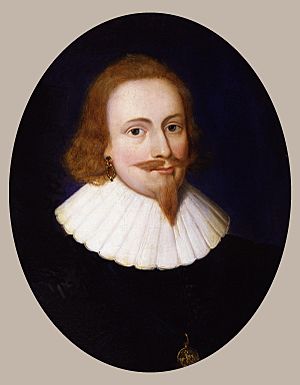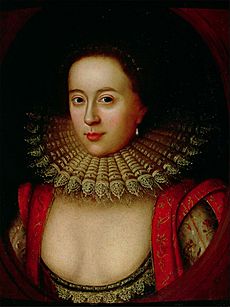Robert Carr, 1st Earl of Somerset facts for kids
Quick facts for kids
The Earl of Somerset
|
|
|---|---|

Portrait of Robert Carr, Earl of Somerset
by John Hoskins |
|
|
|
| Personal details | |
| Born |
Robert Kerr
1587 Wrington, Somerset, England |
| Died | 17 July 1645 |
| Nationality | Scottish |
| Spouse | Frances Howard |
| Children | Anne Russell, Countess of Bedford |
| Parents |
|
| Alma mater | Queen's College, Oxford |
| Occupation |
|
| Known for | Poetry, murder of Sir Thomas Overbury |
Robert Carr, 1st Earl of Somerset KG (c. 1587 – 17 July 1645), was a politician, and favourite of King James VI and I.
Background
Robert Kerr was born in Wrington, Somerset, England, the younger son of Sir Thomas Kerr (Carr) of Ferniehurst, Scotland, by his second wife, Janet Scott, sister of Walter Scott of Buccleuch. About the year 1601, while an obscure page to Sir George Home, he met Thomas Overbury in Edinburgh. The two became friends and travelled to London together. Overbury soon became Carr's secretary. When Carr embarked on his career at court, Overbury became mentor, secretary, and political advisor to his more charismatic friend, the brain behind Carr's steady rise to prominence.
King's favourite

In 1607, Carr happened to break his leg at a tilting match, at which King James VI and I was in attendance. According to Thomas Howard, 1st Earl of Suffolk, the king taught him Latin. The king subsequently knighted the young Carr and took him into favour. Sir Walter Raleigh had, through his attainder, forfeited his life-interest in the manor of Sherborne, even though he had previously executed a conveyance by which the property was to pass on his death to his eldest son (a conveyance which helped to codify many aspects of the English use of primogeniture, still in practice even today). Unfortunately for Raleigh, this document was rendered worthless by a flaw that gave the king eventual possession of the property. Acting on the advice of Robert Cecil, 1st Earl of Salisbury, his Secretary of State, James conferred the manor on Carr. The case was argued at law, and in 1609 judgment was given for the Crown. Apparently Lady Raleigh received some inadequate compensation, and Carr at once entered on possession. Carr's influence became such that in 1610 he was instrumental in persuading the king to dissolve Parliament, which had shown signs of attacking the king's Scottish favourites. On 24 March 1611 he was created Viscount Rochester, and subsequently a Privy Councillor.
Marriage to Frances Howard
When Salisbury died in 1612, James had the notion of governing in person as his own chief Minister of State, with Carr carrying out many of Salisbury's former duties and acting as the king's secretary. But James' inability to attend closely to official business exposed the government to factionalism. The Howard party, consisting of Henry Howard, 1st Earl of Northampton; Thomas Howard, 1st Earl of Suffolk; his son-in-law William Knollys, 1st Earl of Banbury; Charles Howard, 1st Earl of Nottingham, and Sir Thomas Lake, soon took control of much of the government and its patronage. Even the powerful Carr, hardly experienced for the responsibilities thrust upon him and often dependent on his intimate friend Overbury for assistance with government papers, fell into the Howard camp. He had done this after beginning an affair with Frances Howard, Countess of Essex, daughter of the Earl of Suffolk.
Overbury mistrusted the Howards and still had Carr's ear, and tried to prevent the marriage. In order to remove him from court, the Howard faction manipulated Overbury into seeming to be disrespectful to the queen. They then persuaded the king to offer Overbury an assignment as ambassador to the court of Tsar Michael of Russia, aware that his refusal would be tantamount to treason. The plan worked and Overbury declined, wishing to remain in England and at his friend's side. On 22 April 1613 Overbury was placed in the Tower of London at the king's "request", eventually dying there five months later on 15 September "of natural causes".
On 25 September 1613, and supported by the king, Lady Essex obtained a decree of nullity of marriage against her husband, Robert Devereux, 3rd Earl of Essex. On 3 November 1613 Carr was advanced to the Earldom of Somerset, on 23 December appointed Treasurer of Scotland. On 26 December, Lady Essex married Carr.



